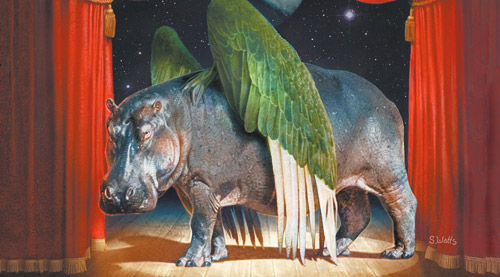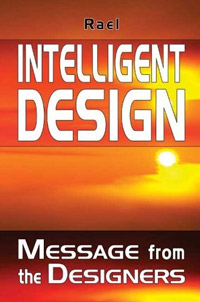Michael Shermer Firewalking
Michael Shermer, publisher of Skeptic magazine and monthly columnist for Scientific American, tries his hand at firewalking barefoot across 1000-degree red hot coals and doesn’t get burned. Dr. Shermer provides a scientific explanation for the mysterious phenomenon.

Skeptic magazine Volume 10 Number 3 (detail of cover, illustration by Stan Watts)
Who Designed That?
Creationism v. Intelligent Design
by Tom McIver

In Who made that?, the widely-repeated Isaac Newton orrery tale,1 the moral is that because all complex mechanical devices must have a maker, so too must the universe have a maker. Creationists extend the same reasoning to animals and human beings: Since we know that people didn’t make the first people or other animals, the maker must have been God. For legal and political reasons, however, Intelligent Design theorists avoid naming God as the Designer. Because of this, ID has been well described as “The Faith that Dare Not Say Its Name.”2
Some traditional creationists, however, strongly resent ID’s reluctance to openly identify the Designer as the Christian God. Ken Ham of Answers in Genesis (AiG), for instance, is skeptical of those creationists who see intelligent design as a battering ram to smash down the constitutional doors and allow the Bible back into schools. “It’s not even against evolution, not really, because they don’t tell you what that intelligence is. It could open a door for Muslim belief, for Hindus, for New Age.”3 “AiG’s Views on the Intelligent Design Movement” laments ID’s evasion regarding the age of the earth and its “refusal to identity the Designer with the Biblical God.”4
At the Answers in Genesis Mega-Conference on Creationism, held at Jerry Falwell’s Liberty University, several speakers criticized ID. John Whitcomb (co-author, with Henry Morris, of The Genesis Flood),5 said it errs in thinking that evolution can be defeated by science and “mere” rationalistic arguments alone without appeal to the Bible. The tragedy of ID, he warned, is that it deliberately stops short of honoring God, trying to appeal to all anti-evolutionists without bringing in religion.
Georgia Purdom of AiG dismisses ID as “refurbished Natural Theology.” The Natural Theology movement, she said, aimed to provide knowledge of God apart from the Bible, but failed in promoting belief in biblical Christianity. ID investigates the effects of intelligent (divine) cause but not the Intelligent Cause — the Christian God — Himself.6
Equal Opportunity Design
In order to deny unconstitutional sectarian religious purpose, ID leaders claim publicly not to be concerned about the identity of the Designer. The designer, they say could be a god of any religion, not necessarily the Christian God of the Bible, and perhaps not even a supernatural deity at all. If we play out this argument, then all candidates would be equally plausible, including the Demiurge of Gnostic belief. In Gnosticism, the ultimate, purely transcendent God did not create anything physical. It was Plato’s “demiurge” who created the evil physical world. Called Yaldabaoth in the Nag Hammadi gnostic text, On the Origin of the World, the demiurge is frequently equated with Satan.
Neo-gnostics today specifically praise Intelligent Design theory for supporting gnosticism. The “Gnostic Friends Network” (www.enemies.com), in articles such as “Intelligent Design: Proof of the Demiurge?” refer to the creator god Yaldabaoth as a Demiurge, a fallen angel or evil space alien:
The gnostics taught that God was a mad scientist named “Yaldabaoth” who had been created by accident and built the earth as a prison for pre-existent human souls. He cloned Adam, raped Eve, and kicked them both out of Paradise when Christ came in the form of a serpent to liberate them.7
Would IDers really accept this? It is unclear how serious such neo-gnostics are, but — given our American guarantee of religious freedom — if they were to insist on presenting their views in classrooms it would require unconstitutional entanglement with religion just to find out.

The Designer could also very well be Islamic. Islamic creationists have made heavy use of “creation science” materials from traditional creationist organizations, simply omitting references to Christianity. They welcome intelligent design theory even more eagerly, as it comes already stripped of such references. The most prolific Islamic creationist proselytizer, Harun Yahya (a pseudonym), writes books such as Signs of God’s Design in Nature, filled with the standard creationist examples. (His 1995 book includes denying the Holocaust.)8 Again, this does not seem the kind of belief Christian ID activists would want promoted in schools.
ID promoters, claiming their unnamed Designer need not even be a deity, mention ET. Among those who take this idea seriously is Claude Vorilhon (“Raël). Raël claims that extraterrestrials created life on Earth as experiments in genetic engineering. Each human race had separate creator. The ETs’ home planet later tried to destroy Earth when created humans acquired forbidden scientific knowledge, but exiled ET creators helped Noah build a rocket to escape. Deriding the “Neo-Darwinian Myth,” Raël appeals to Paley’s watchmaker argument, though mistakenly attributing it to Einstein. In 1998 Raël updated his theory with Intelligent Design: Message from the Designers.9
Many other extraterrestrials have jumped on the Design bandwagon, spawning a new genre. Zechariah Sitchin promoted the idea that we are the result of deliberate creation by aliens in a series of books beginning in 1976 with The 12th Planet. ETs from the planet Nbiru, he claimed, brought DNA to Earth four billion years ago; later, they genetically engineered the resulting primitive hominids into humans for use as slaves. In “The Case of the Intelligent Designer” and “Creation, Evolution, Intelligent Design,” Sitchin expresses delight at ID’s willingness to accept ETs as the possible Designers.10
Perhaps the Designer has evolved. In Olaf Stapledon’s 1937 sci-fi novel Star Maker, the Intelligent Designer is a thoroughgoing evolutionist, and is himself evolving. Our cosmos is but one in a vast series of creations, some of them non-evolutionist. The results of each successive creation suggest to the Designer ways to modify his next creation.11 Positing an evolving designer would eliminate some vexing problems for creationists, such as existence of species competition and extinction. All species on Earth could be specially created, but during different stages of the Designer’s evolution, thus exhibiting imperfect or conflicting characteristics.
Designers All the Way Down
Because ID officially refuses to identify the Designer, ID could not only be non- or anti-Christian, but could just as well be plural — Multiple Designer theory. Scientifically speaking at least, Multiple Designer theory makes more sense than creation by a single designer. Different species could have been designed by different entities; and certainly different categories of creatures, such as predators and their prey, or parasites and their hosts, suggest separate (and competing) designers.
Theodicy — the problem of the existence of evil — led Darel Finley to conclude that multiple designers must be responsible, and he completely divorces ID from religion. Invoking computer programming and video-game analogies, he proposes that all life on Earth was created by unknown Designers for “entertainment” — ours as well as theirs.12
Even single species could be designed by more than one entity. The following joke, which I first heard on Garrison Keillor’s Prairie Home Companion, suggests either imperfect design or competing designers:
Three engineering students were arguing about who designed the human body. One insisted that the human body must have been designed by an Electrical Engineer because of the perfection of the nerves and synapses. Another disagreed, and exclaimed that it had to have been a Mechanical Engineer: “The system of levers and pulleys is ingenious.” “No,” the third student said, “you’re both wrong. The human body was designed by a Civil Engineer. Who else but a Civil Engineer would have put a toxic waste line through a recreation area?”
Maybe the most logical conclusion is that the human body was designed by a committee of engineers!
Another (probably) apocryphal story has it that a famous scientist, following a cosmology lecture, was accosted by a little old lady who informed him that the Earth does not orbit the Sun, but rests on the back of a turtle. The bemused scientist asks her what the turtle stands on. Another turtle, she replies. “And that turtle?” asks the scientist. “You’re very clever,” she says, “but it’s no use. It’s turtles all the way down.”13

Creationism and ID have this same turtle problem. Positing a supernatural Creator or Designer is not a scientific answer. It can always be asked: who designed the Designer? Logically, it could be designers all the way down — another form of Multiple Designer theory.
Darwin’s Dog, Darwin’s God
Thomas Huxley famously described himself as “Darwin’s bull dog,” and the label stuck. He defended Darwin against detractors and campaigned ceaselessly for evolution, even though disagreeing with Darwin about natural selection. Another important contemporary ally was prominent Harvard botanist Asa Gray. Gray attempted to reconcile evolution with providential Christianity by proposing that God guided or specified the variations acted upon by natural selection. Though exceedingly grateful for Gray’s endorsement of evolution, Darwin could not accept this compromise, as it negated his theory’s reliance on chance variation. In 1860 Darwin wrote to Gray:
But I own that I cannot see as plainly as others do, and as I should wish to do, evidence of design and beneficence on all sides of us. There seems to me too much misery in the world. I cannot persuade myself that a beneficent and omnipotent God would have designedly created the Ichneumonidae with the express intention of their feeding within the living bodies of Caterpillars, or that a cat should play with mice. Not believing this, I see no necessity in the belief that the eye was expressly designed. On the other, I cannot anyhow be contented to view this wonderful universe, and especially the nature of man, and to conclude that everything is the result of brute force. I am inclined to look at everything as resulting from designed laws, with the details, whether good or bad, left to the working out of what we may call chance. Not that this notion at all satisfies me. I feel most deeply that the whole subject is too profound for the human intellect. A dog might as well speculate on the mind of Newton.14
Darwin is here considering the possibility that natural laws and initial conditions of the universe were designed, but not individual species: a kind of design that allows for fully naturalistic evolution. He is also movingly confessing our inability to solve the problem of evil.
Before Darwin, proponents of “natural theology” unabashedly used examples such as the ichneumons as proofs of supernatural Design. The great entomologist William Kirby appealed to ichneumons as exemplars of providentially provided instinct. In his Bridgewater Treatise (part of the famous book series commissioned to show the “Power, Wisdom and Goodness of God as Manifested in the Creation”) he opined that God “furnished the predatory tribes with organs and offensive arms” because He foresaw the Fall, which introduced death and carnivorous behavior into the world. Parasites and other evil creatures were most likely created “subsequently to the fall of Adam, not immediately or all at once, but when occasions called for such expressions of the divine displeasure.”15
The brilliant amateur entomologist Jean-Henri Fabre, a contemporary of Darwin who never accepted evolution, described ichneumon behavior in exquisite detail.16 After Darwin, creationists continued to appeal to the amazing adaptations of parasitic ichneumons. They became almost an icon of design, displaying miraculous adaptation and instinctive behavior that could not possible have evolved. Adaptations of both predator and prey species would seem to favor multiple and competing Designers, but creationists, unbothered by the apparent cruelty, interpreted these simply as additional proofs of God’s Design.
After Darwin, creationists continued to point to the adaptive behavior of ichneumons.17 “The very intricacy of the scheme used by this wasp demands that some superior Intelligence devised the entire thing,” said one creationist.18 Another declared that such wasps not only refute evolution but tell us “something about a Creator who obviously had a lot of architectural expertise along with a pretty ingenious imagination.”19
ID theorist Jonathan Wells maintains that God didn’t design bad things such as ichneumons, just the good stuff. Bad things result from degeneration by “micro-evolution.” Strict creationist Purdom shuns such reasoning, accusing ID of making God the author of evil instead of attributing it to Original Sin.20 This is valid criticism of ID but shows that any creationist explanation requires consideration of God’s purpose, attributes, and personality — thus entangling it with religion. Some creationists celebrate examples of parasitic adaptation as proving Design while blithely ignoring the theological problem of evil that this opens up. IDers try to ignore this problem or dismiss it as “micro-evolution,” but are then called to account by many of their more openly creationist brethren.
Creationists All the Way Up

ID theory claims to be scientific and not religious. In its most general sense, such as the “designed laws” mentioned as a possibility by Darwin, belief that God created the universe or natural laws need not conflict at all with evolution. This is not, however, what ID activists are after. Like other creationists, they oppose evolution, denying common ancestry of humans and other animals. Some allow for limited evolution (the “micro-evolution” accepted by many creationists), and a few, such as Michael Behe, will even admit common ancestry, but all reject “naturalistic” evolution: evolution that operates solely by natural law, via natural selection, without supernatural input. In the spectrum of Intelligent Design belief — or what they like to call their “big tent” enclosing all who accept “mere creation” — we find that it is indeed creationists all the way up.
All creationist arguments inevitably lead to entanglements with religion and theology with questions regarding the designer’s identity or nature. They result in discussion about the intent of the designer, why ID designed things the way they are. Why sub-optimal design, like human weak knees and bad backs? Why apparent cruelty, such as evidenced by the ichneumons? Why parasites? Why death at all? If a designer is responsible, these all lead to religious rather than scientific responses. We have seen, with respect to predators and parasites, that whatever the response, all creationist explanations end up either confronting or conspicuously avoiding the problem of evil: a religious and theological issue.
William Paley, whose 1802 Natural Theology promoted the argument from design, was adamant that the design argument revealed the personality of the Creator, and demonstrated that He was the Christian God of the Bible.21 Modern IDers try to deny that it reveals anything about the Designer other than his existence, but fellow creationists such as Morris, Ham, and Purdom chastise them for disguising and hiding from the true religious issue.
Evolution can be accepted with or without belief in God or the Bible, but teaching creationism, including ID creationism, requires entanglement of religion with science. Trying to hide, disguise, or deny the identity of the designer does not alter this. Pretending that the intent, purpose, and result of ID teaching is scientific rather than religious does not divorce ID from religion; instead, it results in even greater entanglement with even more religious beliefs.
References & Notes
- McIver, Tom. 2003. “‘Who Made It?’ The Isaac Newton Orrery Story: Another Mythic Tale Misused by Creationists.” Skeptic 10(3):84–93.
- Coyne, Jerry. 2005. “The Faith That Dare Not Say its Name.” New Republic, Aug 22/29: 21–33.
- Powell, Michael. 2005. “In Evolution Debate, Creationists are Breaking New Ground.” Washington Post, Sep. 25:A3.
- Wieland, Carl. 2002. “AiG’s Views on the Intelligent Design Movement.” www.answersingenesis.org/docs2002/0830_IDM.asp
- Whitcomb, “The History and Impact of the Book The Genesis Flood.” Paper presented at Creation Mega-Conference (Lynchburg VA), July 18.
- Purdom, George. 2005. “The Intelligent Design Movement: How Intelligent Is It?” Paper presented at Creation Mega-Conference (Lynchburg VA), July 20.
- Gnostic Friends Network. “Intelligent Design: Proof of the Demiurge?” www.enemies.com
- Yahya, Harun. 2001. Signs of God: Design in Nature. Istanbul: Global. ___. 1995. Soykırım Yalanı [Holocaust Deception]. Istanbul: Alem.
- Raël (Claude Vorilhon). 1986. Let’s Welcome Our Fathers from Space: They Created Humanity in their Laboratories. Tokyo: AOM. ___. 1998. Intelligent Design: Message from the Designers. At www.rael.org.
- Sitchin, Zechariah. 2002a. “The Case of the Intelligent Designer.” http://www.sitchin.com/designer.htm ___. 2002b. “Creation, Evolution, Intelligent Design.” Fate, Nov.
- Stapledon, Olaf. 2004 [1937]. Star Maker. Wesleyan Univ. Press.
- Finley, Darel Rex. 2005. Mechanism: The Ugly Truth That Nobody Wants to Know. http://alienryderflex.com/mechanism/
- Stephen Hawking, in relating this anecdote at the beginning of his Brief History of Time, suggests the scientist was Bertrand Russell. Other versions identify him as Thomas Huxley, Carl Sagan, and others.
- Darwin, Charles. 1959. Autobiography. New York: Harcourt, Brace.
- Kirby, William. 1835. On the Power, Wisdom and Goodness of God as Manifested in the Creation of Animals and in their History, Habits and Instincts. London: Pickering, pp. 11–13.
- Fabre, Jean-Henri. 1915. The Hunting Wasps. New York: Dodd and Mead.
- Custance, Arthur. 1975. Man in Adam and in Christ. Grand Rapids MI: Zondervan, pp. 58–60.
- Meldau, Fred John. 1974 [1959]. Why We Believe in Creation Not Evolution. Denver: Christian Victory, pp. 102–103.
- Vandeman, George. 1978. Tying Down the Sun. Mountain View CA: Pacific Press, pp. 83–84.
- Purdom, 2005.
- Paley, William. 1802. Natural Theology. London.









